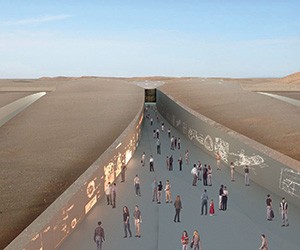The iconic U.S. Route 66, often referred to as the Main Street of America, has an interesting history and tourist appeal in New Mexico.
According to Jim Luttjohann, executive director at the Santa Fe CVB, Santa Fe’s portion of the highway was abandoned in 1937.
“Some say because of practical concerns, making the road straighter and cutting 100 miles off the trip across the state, others point to political retribution for a lost gubernatorial election,” he says. “Yet there remains a history and landmarks from when 66 pierced the state’s capital city.”
In Albuquerque, Central Avenue was originally Route 66, and it still serves as the city’s main thoroughfare today.
Cecilia Padilla-Quillen, director of convention services at the Albuquerque CVB, says it connects the main neighborhoods of the city—Old Town, downtown and Nob Hill—making navigation easy for visitors.
Following are a few noteworthy stops along Route 66 in Santa Fe and Albuquerque.
- The route came into Santa Fe along the original path of the Santa Fe Trail. As it enters town, the path goes past San Miguel Mission, known as the Oldest Church. According to Luttjohann, it’s a beautiful and rustic example of the mission style of churches and one of the most photographed buildings in Santa Fe, “especially in the evening when it catches the day’s late light,” he says.
- La Fonda, one of Santa Fe’s most popular group-friendly hotels, sat on a corner of Route 66 as it passed through the heart of downtown.
“Today, La Fonda’s style, decor and feel keep the days of the Mother Road alive,” Luttjohann says. - The Loretto Chapel features one of Santa Fe’s most popular attractions, the Miraculous Staircase.
“The story of the Miraculous Staircase is both charming and mysterious, while the staircase itself is remarkable to see and still attracts architects and historians to study its form and creation,” Luttjohann says.
- In Albuquerque, the KiMo Theatre was built in 1927 and its name means “King of its Kind” in the native language, according to Padilla-Quillen.
“It is an excellent representation of a short-lived architectural style called Pueblo Deco, with elaborate decoration all throughout the building,” she says, adding that the theater is open for tours on days it is not in use.
- The Turquoise Museum is an interesting attraction along Central Avenue just west of Old Town, where Padilla-Quillen says groups can schedule a talk about turquoise, which is a good idea before they enjoy free-time shopping around Albuquerque.
“They offer hands-on exhibits along with turquoise lapidary demonstrations for groups,” she says.
- The Historic Nob Hill community in Albuquerque is one of the best representations of Route 66 architecture in the country, according to Padilla-Quillen.
“All of the businesses have obviously been repurposed, but many of the original buildings are still intact with kitschy shops, galleries and restaurants,” she says.



